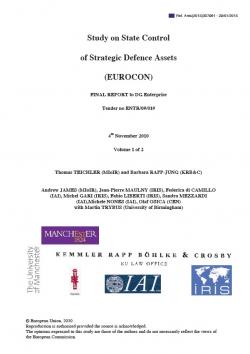Study on State Control of Strategic Defence Assets
Questo studio, finanziato dalla Direzione generale Imprese e Industria della Commissione europea, ha analizzato la prassi corrente del controllo statale degli asset strategici di difesa, ha elaborato le opzioni di una dimensione europea di tale controllo, ha valutato tali opzioni e ha raccomandato una linea d'azione.
-
Dati bibliografici
Bruxelles, Commissione europea, 4 novembre 2010, 287 p. + Annex (388 p.)
Executive Summary
A Analysis of the Current Situation
1 The problem and its political and legal context
1.1 Starting point: Current patchwork of controls might prevent defence industrial consolidation
1.2 Politicians seek to reconcile national security and a liberal trade order
1.3 The EU legal context is favourable to European solutions
1.4 A European solution would be compatible with international law and agreements
2 Cross-country examination of national control regimes
2.1 Government ownership is still a significant means of control
2.2 Special rights are used in four EU countries
2.3 National regulation of control varies significantly across EU countries
2.4 Most EU case study countries combine several means of State control
3 Assessment of the current situation
3.1 Political will remains single most important driver for consolidation
3.2 Governments invoke Art. 346 to avoid application of EMCR, albeit in a varying manner
3.3 Perceptions about openness of EU countries towards defence FDI vary
3.4 State ownership is seen by some stakeholders as impeding consolidation
3.5 Fragmented market for corporate control does not worry most stakeholders
3.6 Current situation lacks transparency and increases uncertainty for investors
3.7 Lack of consultation implies risks for Governments, particularly for security of supply
3.8 Impact of Transfer & Procurement Directives on M&A is for experts too early to judge
3.9 Stakeholders are uncertain as to the most appropriate way forward
B Options for EU Level Action
4 Preliminary Considerations
4.1 The Options address main security risks linked to non-EU investments
4.2 Most Options combine measures regarding the external and the internal dimensions
4.3 Despite Article 346: possibilities for harmonisation exist but are limited
4.4 Six Options for EU level action can be envisaged
5 Six Options for investment control
5.1 Option 1: Directive creating notification & consultation obligations for non-EU investments
5.2 Option 2: Directive harmonising the review of non-EU investments & Interpretative Communication
5.3 Option 3: Regulation on a common review of non-EU investments & Interpretative Communication
5.4 Option 4: Enhanced cooperation enacting Option 1, 2 or 3
5.5 Option 5: CFSP Council Decision on review of non-EU investments & Interpretative Communication
5.6 Option 6: EDA Code of Conduct on notification and consultation or on review of non-EU and EU investments
6 On measures regarding State ownership
7 On measures regarding special rights
7.1 Case-law of the Court on strategic assets exists
7.2 Interpretative Communication could provide guidance
7.3 Further monitoring of special rights is required
C Evaluation of the Options for Investment Control
8 Criteria for the evaluation of the Options
8.1 Legal feasibility looks at legal basis and its viability
8.2 Efficiency assesses to what extent an Option remedies current problems
8.3 Political feasibility investigates political challenges
8.4 Technical challenges examines issues of implementation
9 Evaluation of the six individual Options
9.1 Evaluating Option 1: Directive creating notification & consultation obligations for non-EU investments
9.2 Evaluating Option 2: Directive harmonising the review of non-EU investments & Interpretative Communication
9.3 Evaluating Option 3: Regulation on a common review of non-EU investments & Interpretative Communication
9.4 Evaluating Option 4: Enhanced cooperation enacting Option 1, 2 or 3
9.5 Evaluating Option 5: CFSP Council Decision on review of non-EU investments & Interpretative Communication
9.6 Evaluating Option 6: EDA Code of Conduct on notification, consultation or on review of non-EU and EU investments
D Conclusion and Recommendation
10 Conclusion
11 Recommendation
11.1 On State ownership only limited measures are feasible
11.2 Keep scrutinizing the use of special rights
11.3 Harmonise national investment control legislation in a step-by-step approach
12 Comment on the unrecommended Options
E Bibliography
F List of Appendices in Volume 2/2
Tema
Tag
Contenuti collegati
-
Ricerca18/01/2015
EUROCON - Study on State Control of Strategic Defence Assets
leggi tutto




